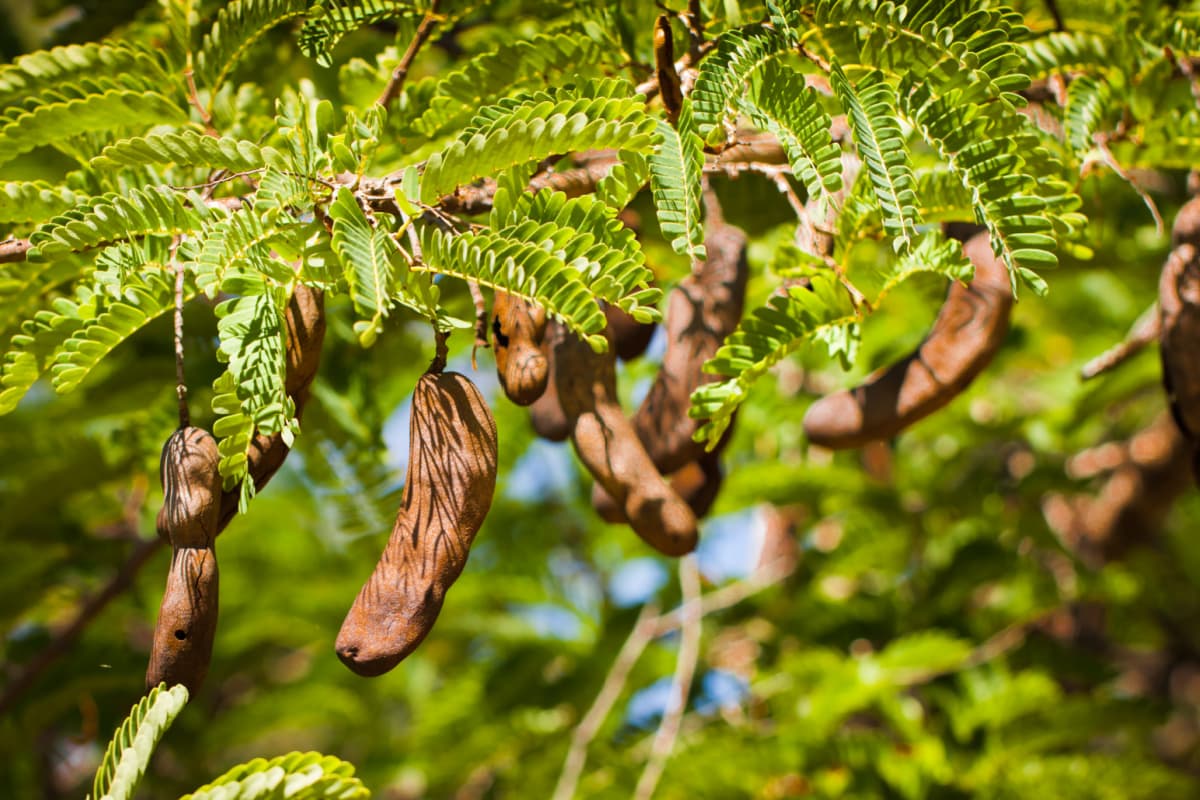Tamarind
Tamarindus indica is the scientific name for the fruit popularly known as tamarind… or if you want to add some Jamaican flavor in it, “tambrin” – the Jamaican colloquial pronunciation of the fruit.
Other popular legumes in this family include chickpeas, peanuts, beans, clover, lentils, lupins, carob, soybeans, alfalfa, and mesquite.
Try this delicious fruit in Tamarind Balls, Tamarind Chutney, and Tamarind Chickpea Chaat!
What Is Tamarind?
The fruit tree is from the genus Tamarindus and belongs to the Fabaceae or Leguminosae family otherwise known as the legume family. Under this family, there are shrubs or trees that are classified as either perennial or annual.
The tamarind tree produces brown pod-like fruits whose dark brown pulp taste ranges from deliciously sweet to mouth-puckeringly sour, slightly tangy to quite tart.
However, the taste is sometimes pungent due to the tartaric acid found in the fruit (this is what gives it the sour taste but despite that, it is a good antioxidant). Find Sour Tamarind Here and Sweet Tamarind Here!
Tamarind is indehiscent- meaning that during the stage of maturity its pods remain closed, unlike some other legumes. The fruit grows in a long bean pod (its shell) where the dark brown pulp grows inside surrounding medium size dark brown seeds like a capsule.
Where Is Tamarind Grown?
The tamarind fruit tree is native to Africa and considered to be from Asia as well. It is grown in tropical and subtropical regions but is widely grown globally now.
Where Can I Buy Tamarind?
Sometimes we overlook it, but tamarind pods are sold in many major supermarkets, and also most Asian and Latino groceries here in the USA. They are usually in boxes where you’ll find the fruit ready and waiting for you to purchase. You can also purchase sweet or sour tamarind from online stores like Amazon.
What Is Tamarind Used For?
A lot of people are unaware of the fruit itself much less its uses. Here are some things you can do with tamarind:
- You can eat the fruit raw or cooked or as that ‘secret’ ingredient. Eating it raw has many benefits but some people tend to add sugar to reduce the sour taste in the form of tamarind balls. In addition, persons have made tamarind chutney or used it as a tenderizer due to its acidity.
- The leaves are used in soups, in the form of tea or soaked and used for healing wounds.
- Tamarind Juice!
Cuisines That Use Tamarind:
- Jamaica, Cuba, other Latin-American countries – The tamarind is rolled in sugar into balls, in which its given name is ‘tamarind ball’.
- India – tamarind chutney and paste.
- Costa Rica – They mostly use it for jams.
- Thailand – The seeds are used as substitutes for coffee beans.
- Bahamas – Used in the form of a sauce
How To Eat Tamarind?
Wondering how to eat it? Don’t worry we’re here to help! Just follow these simple instructions and you should be ok.
- Wash the pods with water then dry them.
- Crack open the shell.
- Then strip away the vines attached to the pulp.
- Chew or suck the pulp but be mindful of the seed.
- Enjoy the riches it offers!
Check Out My Tamarind Sauce Recipe Here!
Forms Of Tamarind
The following are three popular forms of tamarind:
- Raw tamarind pods – This form of tamarind is free from additives or preservatives, giving you that raw and natural taste of the fruit. It is packaged with the pulp still intact in its brown pod.
- Compressed or pressed blocks – In this form tamarind’s pulp is pressed in the form of a block without its shell/pod. It is said that the more moist the tamarind block is, the better it is for usage. Once opened, store it in your refrigerator.
- Tamarind concentrate – In this form, tamarind is packaged as a paste that is unsweetened.
Tamarind Leaves and Seeds
Yes, tamarind is one of those fruits where its seeds and leaves are edible too. A few people have roasted the seeds to consume them, because of it having nutrients.
Moreover, the leaves are high sources of niacin and vitamin C (ascorbic acid) as well as other nutrients. Many use the leaves for various reasons but the two popular ones of them are; tea and in the soup as ‘uplifters’. Tamarind tea has shown to help relieve cold, cough, and sore throat.
How Is Tamarind Tea Made?
Well, it’s really simple; wash and boil some of the leaves in water for about 7 minutes, then sweeten them with your favorite sweetener.
If you purchased tamarind tea bags then that’s great! Just add the tea bag to a cup of hot water then sweeten.
However, how strong you want the tea to be lies within how long you make the teabag in the water remain or how long you boil the leaves.
In addition, you can squeeze a bit of lime then Bon Appetit! Knock that cold or flu out to feel better.

Health Benefits Of Tamarind:
We eat tamarind but what is it good for? What nutrients is it supplying my body with? Read More Here. Well, tamarind has good sources of:
1. Vitamin A (RAE):
This nutrient assists in improving your eyesight, supports the immune system, may reduce the risk of acne, is vital for fetal development (as well as fertility), and helps your lungs, heart, and kidney (Vitamin A may assist with the reduction of urinary stone formation) to operate effectively.
2. Vitamin B1 (Thiamin):
This nutrient is needed by the tissues in your body in order to function/operate effectively. It protects the brain, vital for metabolism, reduces the risk of beriberi, and assists in digestion.
Also, it is vital to the functionality of the cardiovascular system, a cofactor (a helper molecule that aids in biochemical transformation or catalyst for an enzymatic reaction) in enzymatic reactions for the brain, skeletal muscles, heart, liver, and kidney.
A fun fact– Vitamin B-1 is the first vitamin to be discovered by scientists, hence the name Vitamin B-1.
3. Vitamin B2 (Riboflavin):
This vitamin helps converts carbohydrates into ATP (adenosine triphosphate produces energy that the body requires to fuel chemical/ cellular processes), and maintains energy supply in the body.
It also assists in the breakdown of macronutrients (protein, carbohydrates, and fats), absorbs and activates iron and other nutrients (e.g. Vitamin B 1,3 and 6 as well as folic acid) and aids in hormone production.
4. Vitamin B3 (Niacin):
Despite its primary benefit is to lower high cholesterol, niacin also boosts better brain functionality, maintains your skin, nervous system, and digestive system healthy as well as converting the food we consume into energy.
5. Vitamin B5 (Pantothenic acid):
We all require pantothenic acid in order to manufacture coenzyme A (CoA) (essential for fatty acid metabolism by regulating nitric oxide) as well as to synthesize and metabolize macronutrients like proteins, carbohydrates, and fats.
6. Vitamin B-6 (Pyridoxine)-
This is the body’s energy storer! Yes, it uses energy too that it obtained from carbohydrates, proteins, and fats.
Let’s not forget that it’s a mood stabilizer and helps to stimulate the thyroid to assist in weight loss!
It also aids in the production of hemoglobin, may treat eye diseases, may treat inflammation (caused by rheumatoid arthritis), may increase brain functionality, and may reduce the risk of heart disease.
7. Vitamin B9 (Folate):
This vitamin converts carbohydrates into energy as well as aid to produce DNA and RNA and assist to manufacture white and red blood cells.
8. Vitamin C (Ascorbic acid):
Vitamin C is widely known to improve your immune system but what else? Well, this nutrient found in tamarind helps to: protects cells, maintains a healthy cartilage/teeth/bones/skin/blood vessel, prevent/treat scurvy, assist with wound healing, and repair tissues.
Also, vitamin C helps produces enzymes that procreate neurotransmitters (these are the chemical messengers in your nervous system that transmit messages from a nerve cell across a synapse to another target cell e.g. another nerve cell), absorbs iron and many other body functions.
9. Vitamin E (Alpha-tocopherol):
This vitamin assists in improving the immune system, improves vision, may lower risk of cancer, helps to prevent inflammation, and may improve skin health and appearance.
Other Amazing Nutrients in Tamarind:
1. Calcium:
Fortify the bones, muscles, and teeth as well as protect your body from cancer, high blood pressure, and diabetics. You need calcium so that your heart, muscles, and nerves may function properly too.
2. Copper:
Having a good amount of copper, this nutrient in tamarind helps to fight against cardiovascular diseases, fortify bones and muscles that will fight against osteoporosis, and aid in keeping blood vessels intact.
3. Iron:
This mineral is the main contributor for producing hemoglobin, vital for regulating body temperature, helps to improve the immune system, aids in brain function for better focus, helps in gastrointestinal processes, and helps in producing energy.
4. Magnesium:
Yes, tamarind has magnesium! Magnesium regulates; blood pressure, blood sugar levels, and muscle and nerve functions. It also assists in the production of protein, DNA, and bone.
5. Phosphorus:
This mineral regulates hormone imbalance, aids in the growth, repair, and maintenance of cells and tissues as well as aids in digestion.
It also assists in the development of bones and teeth as well as instruct the body on how to use carbohydrates and fats.
Did you know that phosphorus is the second most abundant mineral found in the human body? As well as it is found in every cell?
6. Potassium:
This mineral in tamarind helps your cardiac and respiratory muscles (as well as others) to function or work efficiently and effectively. It also helps with nerve functionality.
7. Zinc:
This nutrient helps to regulate your sense of smell and taste, improves the immune and metabolism system, and assist in wound healing.

How to Store Tamarind:
A quick thing to note is its storage! Refrigerating tamarind is a recommended better way of sustaining the nutrients in the fruit and retain shell life rather than to keep in a cool area.
Disclaimer:
Do not intake too much of the concentrated tamarind, especially from unknown sources, where it may include compounds that are harmful/poisonous e.g. lead.
Conclusion:
Raise your hand if you didn’t know that tamarind had so many health benefits. We learn each day, right? Another thing to know about tamarind is that it contains polyphenols which possess antioxidant, antifungal, antibacterial, antiviral, and anti-inflammatory characteristics.
Due to this, these may protect/ fight against diseases such as; heart disease, diabetes, and cancer. In addition, the seed extract may help to lower blood sugar, while the pulp extract may help you lose body weight and other benefits.
We hope you found this article useful and with that said Bon Appetit!
More Tropical Fruits:
- Tuna Fruit
- Florida Pomelo
- Naseberry/Sapodilla
- Papaya
- Loquat Fruit
- Ground Cherries
- Key Lime
- Seville Orange
- Guinep
- Golden Kiwi
- Egg Fruit
- Black Sapote
If you enjoyed this post about Tamarind and would love to see more, join me on Youtube, Instagram, Facebook & Twitter!
Join Our Facebook Juice Support Group
Love seasonal recipes? Don’t miss out on my special offer for a limited time! Grab all three of my cookbooks for just $19.99! They’re filled with delicious, healthy dishes that are perfect for every season. Hurry and get your set before the offer ends!










